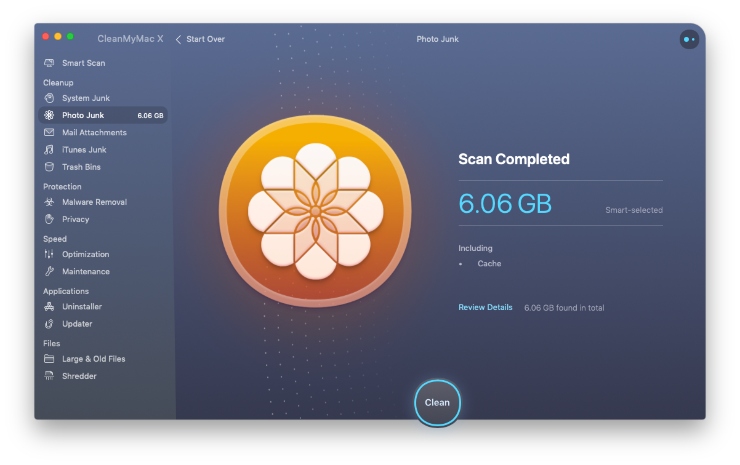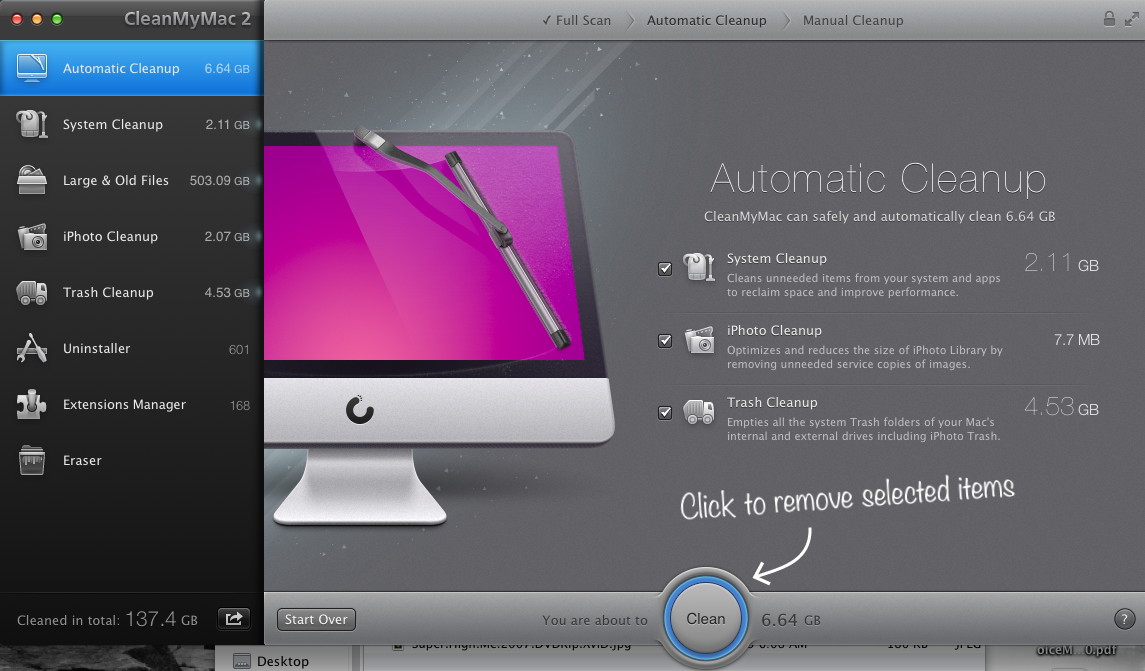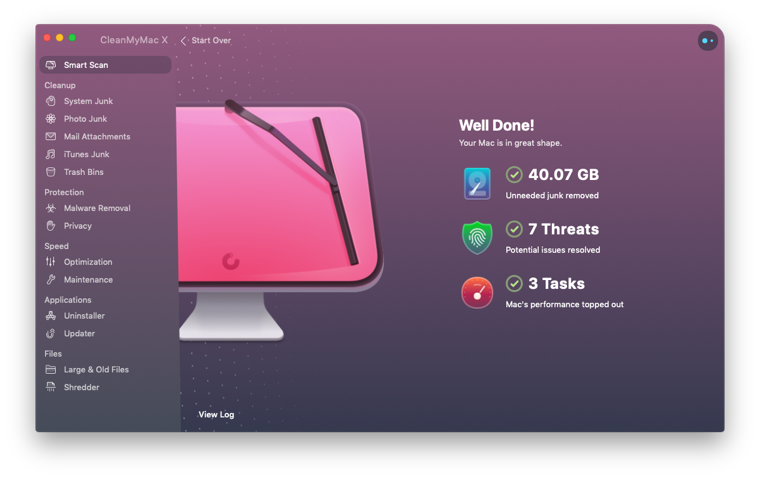Optimized Storage in macOS Sierra and later* can save space by storing your content in iCloud and making it available on demand. When storage space is needed, files, photos, movies, email attachments, and other files that you seldom use are stored in iCloud automatically. Each file stays right where you last saved it, and downloads when you open it. Files that you’ve used recently remain on your Mac, along with optimized versions of your photos.
* If you haven't yet upgraded to macOS Sierra or later, learn about other ways to free up storage space.
It knows which files are useless, how to find them and remove completely. CleanMyMac has everything to finish the 3-hour task of a Mac cleanup in under 5 minutes. It will even clean up the junk you didn’t know about and give your computer a speed boost. How to clean up system storage on Mac with CleanMyMac X: Download CleanMyMac X for free. Aug 14, 2011 What is the best software program to buy to clean up my mac? Leave your Mac on one night a month, (not in Sleep mode) so it can run maintenance tasks for you. Read here Mac OS X: About background maintenance tasks. If the drive is slow to respond to tasks, you may need to free up.
Find out how much storage is available on your Mac
Choose Apple menu > About This Mac, then click Storage. Each segment of the bar is an estimate of the storage space used by a category of files. Move your pointer over each segment for more detail.
Click the Manage button to open the Storage Management window, pictured below. This button is available only in macOS Sierra or later.

Manage storage on your Mac
The Storage Management window offers recommendations for optimizing your storage. If some recommendations are already turned on, you will see fewer recommendations.
Store in iCloud
Click the Store in iCloud button, then choose from these options: Reset all apps on mac.
- Desktop and Documents. Store all files from these two locations in iCloud Drive. When storage space is needed, only the files you recently opened are kept on your Mac, so that you can easily work offline. Files stored only in iCloud show a download icon , which you can double-click to download the original file. Learn more about this feature.
- Photos. Store all original, full-resolution photos and videos in iCloud Photos. When storage space is needed, only space-saving (optimized) versions of photos are kept on your Mac. To download the original photo or video, just open it.
- Messages. Store all messages and attachments in iCloud. When storage space is needed, only the messages and attachments you recently opened are kept on your Mac. Learn more about Messages in iCloud.
Storing files in iCloud uses the storage space in your iCloud storage plan. If you reach or exceed your iCloud storage limit, you can either buy more iCloud storage or make more iCloud storage available. iCloud storage starts at 50GB for $0.99 (USD) a month, and you can purchase additional storage directly from your Apple device. Learn more about prices in your region.
Optimize Storage
Click the Optimize button, then choose from these options.
- Automatically remove watched movies and TV shows. When storage space is needed, movies or TV shows that you purchased from the iTunes Store and already watched are removed from your Mac. Click the download icon next to a movie or TV show to download it again.
- Download only recent attachments. Mail automatically downloads only the attachments that you recently received. You can manually download any attachments at any time by opening the email or attachment, or saving the attachment to your Mac.
- Don't automatically download attachments. Mail downloads an attachment only when you open the email or attachment, or save the attachment to your Mac.
Optimizing storage for movies, TV shows, and email attachments doesn't require iCloud storage space.
Empty Trash Automatically
Mac create app shortcut on desktop windows 10. Empty Trash Automatically permanently deletes files that have been in the Trash for more than 30 days.
Reduce Clutter
Reduce Clutter helps you to identify large files and files you might no longer need. Click the Review Files button, then choose any of the file categories in the sidebar, such as Applications, Documents, Music Creation, or Trash.
You can delete the files in some categories directly from this window. Other categories show the total storage space used by the files in each app. You can then open the app and decide whether to delete files from within it.
Learn how to redownload apps, music, movies, TV shows, and books.
Where to find the settings for each feature
The button for each recommendation in the Storage Management window affects one or more settings in other apps. You can also control those settings directly within each app.
- If you're using macOS Catalina, choose Apple menu > System Preferences, click Apple ID, then select iCloud in the sidebar: Store in iCloud turns on the Optimize Mac Storage setting on the right. Then click Options next to iCloud Drive: Store in iCloud turns on the Desktop & Documents Folders setting. To turn off iCloud Drive entirely, deselect iCloud Drive.
In macOS Mojave or earlier, choose Apple menu > System Preferences, click iCloud, then click Options next to iCloud Drive. Store in iCloud turns on the Desktop & Documents Folders and Optimize Mac Storage settings. - In Photos, choose Photos > Preferences, then click iCloud. Store in iCloud selects iCloud Photos and Optimize Mac Storage.
- In Messages, choose Messages > Preferences, then click iMessage. Store in iCloud selects Enable Messages in iCloud.
- If you're using macOS Catalina, open the Apple TV app, choose TV > Preferences from the menu bar, then click Files. Optimize Storage selects “Automatically delete watched movies and TV shows.”
In macOS Mojave or earlier, open iTunes, choose iTunes > Preferences from the menu bar, then click Advanced. Optimize Storage selects “Automatically delete watched movies and TV shows.” - In Mail, choose Mail > Preferences from the menu bar, then click Accounts. In the Account Information section on the right, Optimize Storage sets the Download Attachments menu to either Recent or None.
Empty Trash Automatically: From the Finder, choose Finder > Preferences, then click Advanced. Empty Trash Automatically selects “Remove items from the Trash after 30 days.”
Free Mac Clone Software
Other ways that macOS helps automatically save space
With macOS Sierra or later, your Mac automatically takes these additional steps to save storage space:
- Detects duplicate downloads in Safari, keeping only the most recent version of the download
- Reminds you to delete used app installers
- Removes old fonts, languages, and dictionaries that aren't being used
- Clears caches, logs, and other unnecessary data when storage space is needed
How to free up storage space manually
Even without using the Optimized Storage features of Sierra or later, you can take other steps to make more storage space available:
- Music, movies, and other media can use a lot of storage space. Learn how to delete music, movies, and TV shows from your device.
- Delete other files that you no longer need by moving them to the Trash, then emptying the Trash. The Downloads folder is good place to look for files that you might no longer need.
- Move files to an external storage device.
- Compress files.
- Delete unneeded email: In the Mail app, choose Mailbox > Erase Junk Mail. If you no longer need the email in your Trash mailbox, choose Mailbox > Erase Deleted Items.
Learn more
- The Storage pane of About This Mac is the best way to determine the amount of storage space available on your Mac. Disk Utility and other apps might show storage categories such as Not Mounted, VM, Recovery, Other Volumes, Free, or Purgeable. Don't rely on these categories to understand how to free up storage space or how much storage space is available for your data.
- When you duplicate a file on an APFS-formatted volume, that file doesn't use additional storage space on the volume. Deleting a duplicate file frees up only the space required by any data you might have added to the duplicate. If you no longer need any copies of the file, you can recover all of the storage space by deleting both the duplicate and the original file.
- If you're using a pro app and Optimize Mac Storage, learn how to make sure that your projects are always on your Mac and able to access their files.
You can read on this post – Top 5 Mac cleaner reviews – to find out what is the best Mac cleaner for your Macbook, iMac or Mac mini to run more smoothly.
Free Software To Clean Up My Mac
Mac Tips & Issue Fixes
Mac Related Tips
Mac Problems & Fixes
Mac Clean Tips
Free Macbook Clean Up
In fact, even Apple Macs need regular clean up like any other Windows computers. To clean up Mac manually is a laborious task, and it is not nearly enough. That’s how some professional Mac cleaner software comes. An old Mac can store gigabytes of junk files and which can not only take up space but also slows your Mac.
In this article, we have rounded up 5 of the best Mac cleaner software with their reviews and screenshots for you to speed up your Mac by cleaning up all unnecessary junk files on your device. Please check out and find a suitable one for your Mac.
1. Best Mac Cleaner – MacClean 3
Price: $19.99
MacClean offers you “60-Days Money Back Guarantee”, you can ask a refund if you find it doesn’t work well. Get It Now
MacClean is the best Mac cleaner for all Mac desktops and laptops. It is mainly for Mac users who want to clean up and free up Mac hard drive with no effort. https://thisgol.netlify.app/church-office-software-for-mac.html.
Main Features of MacClean
- It is fully capable of detecting and removing all types of junk files – Internet Junk, User Junk, System Junk, Development Junk, and Application Junk from Mac.
- It wipes out malicious cookies and malware from Mac to keep your Mac safe.
- It provides you with 10 useful tools like Duplicates Finder, Old & Large Files Finder, File Eraser, App Uninstaller, and Extension Manager, etc.
- It works all Macs including MacBook, MacBook Pro, MacBook Air, iMac, Mac mini, Mac Pro, etc.
Related Reading: Download MacClean Now >
2. MacPaw CleanMyMac 3
Price: $39.95
CleanMyMac 3 as its name expresses, is an easy to manage Mac cleaning software that made to clean and maintain your Mac. There is a free trial but you need to buy it for $39.95 (License for 1 Mac).
Main Features of CleanMyMac 3
- It helps clean the junk files from your Mac like user cache files, user log files, system log files, broken preferences, iOS software updates, etc.
- It finds out and removes old files from Mac to free up space.
- It manages to delete entire applications, including all the extra files.
- It empties the trash can on Mac and makes it unrecoverable.
Mac Cleaning Software – CleanMyMac 3
Also Read: 11 Ways to Make Your Mac Faster >

3. Mac Cleaning Software – Smart Mac Care
Price: $49.95
Smart Mac Care is an all-in-one tool to keep your Mac healthy and secure by removing malware infections, unwanted junk files and privacy traces.
Main Features of Smart Mac Care
- Malware Scan: It helps you detect and remove malware infections provide security to your system, eliminating unwanted system crashes and abnormal functioning.
- Junk Scan: It can smartly detect cache files, log files, trash etc. that are no longer in use and delete them in few clicks.
- Privacy Scan module scans all the browsers installed on your Mac for Internet history, cookies and application cache.
- It includes some tools like Uninstaller, Duplicate Finder, Failed Downloads and Login Items etc. All of them can help boost system performance and recover considerable hard disk space.

4. Mac Cleaning Software – Detox My Mac
Price: $24.95
Detox My Mac is basically the Mac software cleaner. It is designed to clean up junk stored in the storage space on the Mac and makes the memory space free. There is a free trial of Detox My Mac which allows you to scan and remove logs and trashes like user logs, trash bin, etc. And you need to unlock the full version for $24.95 for more functions.
Main Features of Detox My Mac
- It’s quite simple and easy to use.
- It helps remove only those unused files and documents that clutter your Mac, letting you with a lot of free memory on your Mac.
- It removes unused language files for applications and systems helping free up more disk space.
- It manages to delete unused history files for browsers and applications.
Mac Cleaning Software – Detox My Mac
5. Mac Cleaning Software – AppZapper
Price: $12.95
Removing applications from your Mac is an easy job, however, the leftovers like behind folders and preference files still take hard drive space and generally clutter your system. AppZapper allows you to uninstall application as well as the app left – just drag and drop.
Main Features of AppZapper
Best Mac Cleaner Software
- It is very easy to use, you can uninstall any app by dragging the app onto AppZapper.
- It finds all the extra files left on your Mac and allows you to remove them in a single click.
- It remembers which apps you want to keep safe, and the log tracks all the files you’ve zapped.
You May Like: How to Make Mac Faster in Three Methods >
How To Clean Up My Mac
The Bottom Line
If your Mac computer is getting sluggish, that means its time to clean out it with some Mac cleaner. You can choose one from the above mentioned tools. If you have any good ideas about the best Mac cleaning software, please share it with us in the comment section.
Mac software to burn playable dvd vob files. Product-related questions? Contact Our Support Team to Get Quick Solution >